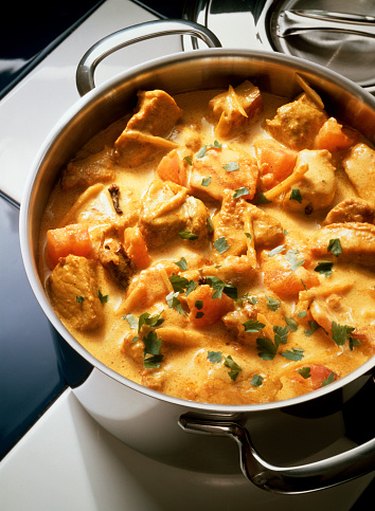Things You'll Need
Stirring spoon
Plain yogurt or sour cream
Coconut milk or cream
Lime or lemon juice
1 can crushed pineapple
Shredded cheese
Chopped cilantro
Rice, crackers or bread

Spice gives flavor and personality to foods, and it is a prominent ingredient in the cuisine of many cultures. If you've decided to give your food a little kick by adding some chopped jalapenos or chilli powder, prepare yourself for serious heat. Too much spice can cause an uncomfortable burning sensation in the mouth and across the tongue. Your dish can be neutralized using other foods in your kitchen. Sugars, acids and dairy all cool down spice to calm the heat and burn.
Step 1
Stir a little yogurt, sour cream, coconut milk or cream into the spicy dish. Add a small amount at a time, tasting as you go. The creaminess will disrupt the heat in your mouth by diluting the spice, coating the mouth and giving the receptors on your tongue a different sensation to focus on. Pair coconut milk or yogurt with dishes such as Thai curry or chicken tikka, and use cream or sour cream with spicy Italian pasta sauces or tacos.
Video of the Day
Step 2
Squeeze the juice of one lemon or lime into the food. Acid neutralizes spice and mellows out the entire dish.
Step 3
Add crushed pineapple, a spoonful at a time, to the spicy dish. Taste as you add. The sugars in the pineapple balance out spice. The pineapple will break down and become barely noticeable as the dish cooks, serving only to neutralize the spice.
Step 4
Serve the spicy dish with a side of shredded cheese or chopped cilantro. Both of these add-ons cool the palate and even out a spicy dish.
Step 5
Pair spicy food with rough, starchy sides such as bread, rice or crackers. Again, the different texture neutralizes the spice. Also, starch helps to absorb some of the heat.
Tip
Cool your mouth by drinking ice-cold, flat soda. Sugary drinks neutralize spice and ice numbs your mouth. Stay away from carbonation as the bubbles can irritate your already-sensitive mouth.
Video of the Day